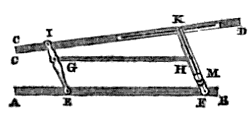Centrolinead

The centrolinead was invented by Peter Nicholson, a British mathematician and architect, in 1814.[1] It was used to construct 2-point perspective drawings where one or both vanishing points existed outside the drawing board. Draftsmen could use the instrument in pairs; one for each vanishing point on each side of the station point.
Centrolineads were produced in various sizes. Typically a brass fitting clamped the wooden arms together. Fittings were produced in both right and left-handed configuration, and certain adjustable designs could be used on either side.
Usage
Two short arms are set to form 90 degree angles against a third, longer drawing edge. Pins are placed near the edges of the drawing surface and serve as pivots for the arms. Pin placement is equidistant and symmetric across the horizontal line. A third centrolinead could be used to construct 3-point perspective.
The diagram shown above does not represent the centrolinead designed by Nicholson.
Further reading
Centrolineads and their use are discussed in W.F. Stanley's book on mathematical instruments.